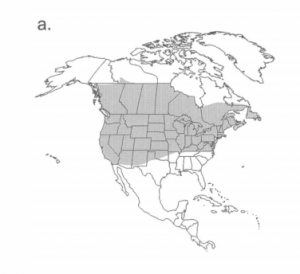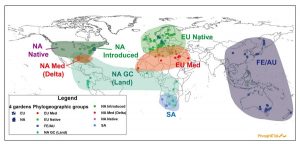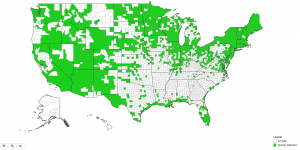December 12, 2018 – Samantha Stanton, Great Lakes Commission
Updated December 14, 2018
Phragmites seems to be everywhere in the Great Lake region – but where did it come from? First, it is important to recognize that there is a subspecies of Phragmites that is native to the North America: Phragmites australis subsp. americanus (see figure 1). Subspecies americanus has been recorded in North America’s fossil record as far as 40,000 years ago1. Check out our Identifying Native vs. Invasive Phragmites blog post to help you differentiate between the two.

Figure 1. Distribution of native Phragmites. From Saltonstall et al. 20022.
If there is native Phragmites in North America, where did the non-native strain originate from? Phragmites australis subsp. australis, the variant that is invasive throughout the Great Lakes region, is native to Europe (see figure 2). One commonly accepted theory is that the non-native subspecies was introduced in the 1800s by ships traveling from European countries1. Early ships used soil as ballast to weigh down their ships until cargo could be loaded and the soil dumped in a new location. There were likely multiple introductions along the Eastern coast of the United States from this and other pathways.

Figure 2. Global distribution of phylogeographic groups of Phragmites austalis. From PhragNet – AARHUS University3.
Though non-native Phragmites has been present in North America for some time, it has only become a true invader in the Great Lakes region over the last few decades. Phragmites’ ability to reproduce asexually as well grow quickly make it a successful invader. Human disturbance and modification of the landscape along with large scale changes such as climate change, are creating more opportunities for invasive Phragmites to invade and establish4.
Millions of dollars are spent annually on non-native Phragmites control and management activities across the Great Lakes basin. The Great Lakes Restoration Initiative (a U.S. federal source of funding) granted over $16 million to Phragmites control activities between 2010 and 20155. We have made great progress on effectively controlling some of the invaded area! However, over much of the basin it continues to expand and can sometimes seem like a losing battle, but there are ways that everyone can do their part…
One of the most daunting problems with non-native Phragmites is that it is constantly expanding its distribution and establishing new, unknown locations. You can help to track the establishment and spread of Phragmites now and in the future by reporting the Phragmites that you see to one of the invasive species mapping services such as EDDMapS or MISIN. You may notice in the map below (figure 3) that your county does not have a reported Phragmites infestation. If you have seen invasive Phragmites, don’t let it go unreported! Report your sighting in the mapping services listed above, or contact your local CISMA/CWMA/PRISM for assistance.

Figure 3. Map of reported Phragmites infestations across the United States6 .
Non-native Phragmites will continue to be a problem for us for many years to come. The invasion within the Great Lakes basin and beyond will continue to shift and change as Phragmites is removed from some areas and established in others. Continuing to track the invasion is one thing we can do to make the daunting task a little more manageable.
References
1 Simberloff, D. (2009). The role of propagule pressure in biological invasions. Annual Review of Ecology, Evolution, and Systematics, 40, 81-102.
2 Saltonstall, K., Peterson, P. M., & Soreng, R. J. (2004). Recognition of Phragmites au straus subsp. americanus (poaceae: arundinoideae) in North America: Evidence from morphological and genetic analyses. SIDA, Contributions to Botany, 683-692.
3 PhragNet. 2018. Understanding range expansion and biological invasions of plants under global change. Available online at https://pure.au.dk/portal/en/projects/phragnet-understanding-range-expansions-and-biological-invasions-of-plants-under-global-change(1a1006b6-8a15-40e6-840f-330d00dc3de5).html; last accessed June 2, 2021.
4 Wilcox, K. L., Petrie, S. A., Maynard, L. A., & Meyer, S. W. (2003). Historical distribution and abundance of Phragmites australis at long point, Lake Erie, Ontario. Journal of Great Lakes Research, 29(4), 664-680.
5 Braun, H. A., Kowalski, K. P., & Hollins, K. (2016). Applying the collective impact approach to address non-native species: a case study of the Great Lakes Phragmites Collaborative. Biological invasions, 18(9), 2729-2738.4 Wilox et al. 2003
6 EDDMapS. 2018. Early Detection & Distribution Mapping System. The University of Georgia – Center for Invasive Species and Ecosystem Health. Available online at http://www.eddmaps.org/; last accessed December 14, 2018.
